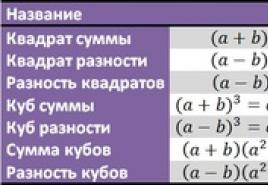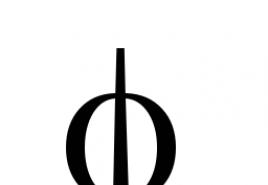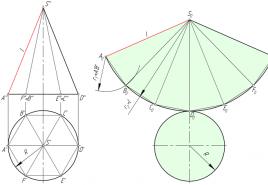Solving inequalities online with roots. Solving inequalities
For example, the expression \ (x> 5 \) is an inequality.
Types of inequalities:
If \ (a \) and \ (b \) are numbers or, then the inequality is called numerical... In fact, this is just a comparison of two numbers. Such inequalities are subdivided into the faithful and unfaithful.
For instance:
\(-5<2\) - верное числовое неравенство, ведь \(-5\) действительно меньше \(2\);
\ (17 + 3 \ geq 115 \) is an invalid numerical inequality, since \ (17 + 3 = 20 \), and \ (20 \) is less than \ (115 \) (not greater than or equal).
If \ (a \) and \ (b \) are expressions containing a variable, then we have variable inequality... Such inequalities are divided into types depending on the content:
|
\ (2x + 1 \ geq4 (5-x) \) |
Variable in the first degree only |
|||
|
\ (3x ^ 2-x + 5> 0 \) |
There is a variable in the second degree (square), but no higher degrees (third, fourth, etc.) |
|||
|
\ (\ log_ (4) ((x + 1))<3\) |
||||
|
\ (2 ^ (x) \ leq8 ^ (5x-2) \) |
What is the solution to inequality?
If you substitute some number in the inequality instead of a variable, then it will turn into a numeric one.
If the given value for x turns the original inequality true numerical, then it is called solution of inequality... If not, then this value is not a solution. And to solve inequality- you need to find all his solutions (or show that they do not exist).
For instance, if we substitute the number \ (7 \) into the linear inequality \ (x + 6> 10 \), we get the correct numerical inequality: \ (13> 10 \). And if we substitute \ (2 \), there will be an incorrect numerical inequality \ (8> 10 \). That is, \ (7 \) is a solution to the original inequality, but \ (2 \) is not.
However, the inequality \ (x + 6> 10 \) has other solutions. Indeed, we get the correct numerical inequalities when substituting both \ (5 \), and \ (12 \), and \ (138 \) ... And how can we find all possible solutions? To do this, use For our case, we have:
\ (x + 6> 10 \) \ (| -6 \)
\ (x> 4 \)
That is, any number greater than four will suit us. Now you need to write down the answer. Solutions to inequalities, as a rule, are written numerically, additionally marking them on the numerical axis with shading. For our case, we have:
Answer:
\ (x \ in (4; + \ infty) \)
When does the sign change in inequality?
There is one big trap in inequalities that students are very fond of falling into:
When multiplying (or dividing) an inequality by a negative number, it changes to the opposite ("more" to "less", "more or equal" to "less or equal" and so on)
Why is this happening? To understand this, let's look at the conversions of the numerical inequality \ (3> 1 \). It is true, the three is really more than one. First, let's try to multiply it by any positive number, for example, two:
\ (3> 1 \) \ (| \ cdot2 \)
\(6>2\)
As you can see, after multiplication, the inequality remains true. And no matter what positive number we multiply, we will always get the correct inequality. Now let's try to multiply by a negative number, for example, minus three:
\ (3> 1 \) \ (| \ cdot (-3) \)
\(-9>-3\)
The inequality turned out to be wrong, because minus nine is less than minus three! That is, in order for the inequality to become true (which means that the transformation of multiplication by negative was "legal"), you need to reverse the comparison sign, like this: \ (- 9<− 3\).
With division it will turn out the same, you can check it yourself.
The rule written above applies to all types of inequalities, not just numerical ones.
Example: Solve the inequality \ (2 (x + 1) -1<7+8x\)Solution:
|
\ (2x + 2-1<7+8x\) |
Move \ (8x \) to the left, and \ (2 \) and \ (- 1 \) to the right, not forgetting to change the signs |
|
\ (2x-8x<7-2+1\) |
|
|
\ (- 6x<6\) \(|:(-6)\) |
Divide both sides of the inequality by \ (- 6 \), not forgetting to change from "less" to "more" |
|
Let's mark the numerical interval on the axis. Inequality, therefore the very value \ (- 1 \) is "gouged out" and in response we do not take |
|
|
Let's write the answer as an interval |
Answer: \ (x \ in (-1; \ infty) \)
Inequalities and DHS
Inequalities, as well as equations, can have restrictions on, that is, on the x values. Accordingly, those values that are unacceptable according to the DHS should be excluded from the decision gap.
Example: Solve the inequality \ (\ sqrt (x + 1)<3\)
Solution: It is clear that in order for the left side to be less than \ (3 \), the radical expression must be less than \ (9 \) (after all, from \ (9 \) just \ (3 \)). We get:
\ (x + 1<9\) \(|-1\)
\ (x<8\)
Everything? Any x value less than \ (8 \) will suit us? Not! Because if we take, for example, the value \ (- 5 \) that seems to be suitable for the requirement, it will not be a solution to the original inequality, since it will lead us to calculate the root of a negative number.
\ (\ sqrt (-5 + 1)<3\)
\ (\ sqrt (-4)<3\)
Therefore, we must also take into account the restrictions on the x values - it cannot be such that there is a negative number under the root. Thus, we have the second requirement for x:
\ (x + 1 \ geq0 \)
\ (x \ geq-1 \)
And for x to be the final solution, it must satisfy both requirements at once: it must be less than \ (8 \) (to be a solution) and more than \ (- 1 \) (to be valid in principle). Plotting on the number axis, we have the final answer:

Answer: \ (\ left [-1; 8 \ right) \)
Inequality it is an expression with, ≤, or ≥. For example, 3x - 5 Solving an inequality means finding all values of the variables for which this inequality is true. Each of these numbers is a solution to the inequality, and the set of all such solutions is its many solutions... Inequalities that have the same set of solutions are called equivalent inequalities.
Linear inequalities
The principles for solving inequalities are similar to those for solving equations.Principles for solving inequalities
For any real numbers a, b, and c:
The principle of adding inequalities: If a The multiplication principle for inequalities: If a 0 is true, then ac If a bc is also true.
Similar statements also apply for a ≤ b.
When both sides of an inequality are multiplied by a negative number, the sign of the inequality needs to be reversed.
The first level inequalities, as in example 1 (below), are called linear inequalities.
Example 1 Solve each of the following inequalities. Then depict many solutions.
a) 3x - 5 b) 13 - 7x ≥ 10x - 4
Solution
Any number less than 11/5 is a solution.
The set of solutions is (x | x
To check, we can plot y 1 = 3x - 5 and y 2 = 6 - 2x. Then it is clear from this that for x 
The set of solutions is (x | x ≤ 1), or (-∞, 1]. The graph of the set of solutions is shown below. ![]()
Double inequalities
When two inequalities are connected by a word and, or, then it is formed double inequality... Double inequality like
-3
and 2x + 5 ≤ 7
called connected because it uses and... Writing -3 Double inequalities can be solved using the principles of addition and multiplication of inequalities.
Example 2 Solve -3 Solution We have
The set of solutions (x | x ≤ -1 or x> 3). We can also write a solution using spacing notation and a symbol for amalgamations or inclusions of both sets: (-∞ -1] (3, ∞). The graph of the solution set is shown below. 
To test, draw y 1 = 2x - 5, y 2 = -7, and y 3 = 1. Note that for (x | x ≤ -1 or x> 3), y 1 ≤ y 2 or y 1> y 3. 
Inequalities with absolute value (modulus)
Inequalities sometimes contain modules. The following properties are used to solve them.
For a> 0 and an algebraic expression x:
| x | | x | > a is equivalent to x or x> a.
Similar statements for | x | ≤ a and | x | ≥ a.
For instance,
| x | | y | ≥ 1 is equivalent to y ≤ -1 or y ≥ 1;
and | 2x + 3 | ≤ 4 is equivalent to -4 ≤ 2x + 3 ≤ 4.
Example 4 Solve each of the following inequalities. Plot the set of solutions.
a) | 3x + 2 | b) | 5 - 2x | ≥ 1
Solution
a) | 3x + 2 |

b) | 5 - 2x | ≥ 1
The solution set is (x | x ≤ 2 or x ≥ 3), or (-∞, 2])







